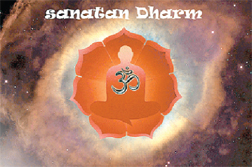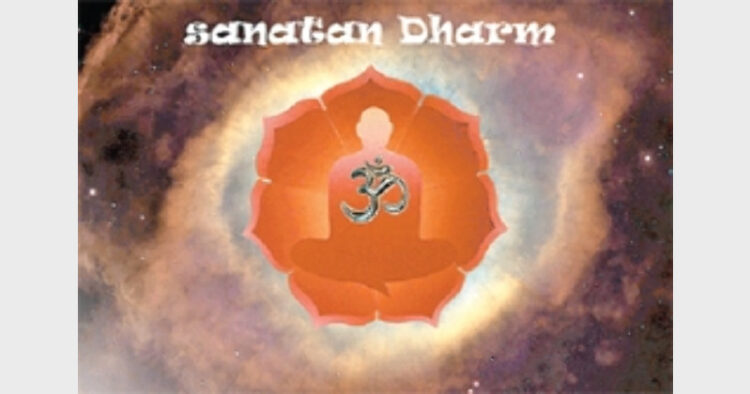 Intro: It is the leftist secularist baseline that has been fed to the population for the past century as the only proper garment to clothe the ancient Indian spirit. Here lies the problem.?
Intro: It is the leftist secularist baseline that has been fed to the population for the past century as the only proper garment to clothe the ancient Indian spirit. Here lies the problem.?
It is of course imperative that India awakens, but that must be to re-establish her true civilisational underpinnings. This is referred to aptly as the Sanatana Dharma, her eternal Law of Truth.?
There is a void in the country, a void many thinkers are seeking to fill. A recent article in The Hindu, on 11.12.2014, entitled ‘Confronting the Right Wing’, by Shiv Visvanathan, is the purest example so far of the absence of a vision that can support attempts being made to bring India forward to express her highest destiny, as each ‘wing’ sees fit. For one of these, in the last century Swami Vivekananda had rightly given the call for India to be recognised as the Vishwa Guru, the World Teacher. This goal has been refurbished today to suit modern demands. Thus, the focus now is on uplifting India materially in the belief that in so doing her cultural heritage will almost on its own re-emerge from beneath the disfiguring veils of poverty, backwardness and ignorance, and shine forth today in the glorious forms of the past – as it was then, so it is today.
Actually, this is the basic line of thinking of all fundamentalists. There are religious fundamentalists as well as fundamentalists of the contemporary ideologies; the latter are on the rise now, given the success of the RSS in placing its agenda in the forefront, at what is, without a doubt, a major turning point in India’s destiny.
As passionate and as well-intentioned as thinkers such as Visvanathan may be, the fact is he and others seek to re-bottle an old and now stale wine. Here lies the problem. It is this leftist secularist baseline that has been fed to the population for the past century as the only proper garment to clothe the ancient Indian spirit. The author offers nothing new. His is, quite simply put, a call to arms: Let us organise our armies – our scholars, intellectuals, activists, political thinkers to demolish entirely the wave that is sweeping across the land. Contrary to what the author would want, his call is simply to tear down, to destroy – not to build. Nor does he question why the wave has burst forth with such triumphant vehemence.
The question to rightly ask is what has been lacking in the nation for over a century that has fuelled the wave, the first rumbling of which was the demolition of the disputed structure at Ayodhya in 1992? From that point onward scholars and political analysts have sought to badger the people with one simple agenda: at all cost, the wave must be suppressed and that 1992 ‘madness’ used as a tactic to constantly remind the nation of the horrific results of fundamentalism. Not once has the right question been asked: Why did the event take place at all? What has been lacking in the national discourse to have allowed such an eruption of what the presiding intellectuals loathe the most?
The answers can be found in Shiv Visvanathan’s article, and many others appearing of late that seek to ignite a fire in intellectuals that can dissolve the unstoppable wave which they believe will carry India to a Stone-Age mindset if not effectively contested immediately.
However, that ‘fire’ requires an altogether new fuel if it is to satisfy the nation. There is no time for experiments: five years of Left rule, then five of the Right, back and forth on the political see-saw. It is of course imperative that India awakens, but that must be to re-establish her true civilisational underpinnings. This is referred to aptly as the Sanatana Dharma, her eternal Law of Truth. A dharma that is eternal implies an in-built mechanism of renewal that effortlessly embraces and integrates the circumscribing conditions the civilisation meets in the course of evolution.
India has managed to preserve that foundational base and carry it forward into the 21st Century. In spite of all the vicissitudes, the fumblings, the missteps and falls, the base is preserved and requires simply the act of resuscitating the body that lies dormant beneath the veils of the ages – not dead as all once-great ancient civilisations are, but merely in a slumber while waiting for the appropriate time for resuscitation. That moment began early in the last century; it has been a long process, the culmination of which is being reached in our very own times.
Recently, Ganga herself has conveyed the same message: the time has come. In June of 2013, the divine Ganga conveyed the message that time is running out. She broke through seemingly ironclad barriers, crashing over whatever stood in her way as she delivered the message that no resistance would be brooked: the time for change has come; no longer can society continue paying mere lip service to the Goddess. Progress yes, development, by all means; but not at the cost of a degradation of the portion of planet Earth that is destined to play a special role in the comity of nations. The land over which Ganga flows must not continue to be degraded or she will once again express her displeasure, each time with increasing vehemence.
The Future Realisation, an offering of Aeon Centre of Cosmology at Mati Ghar of the Indira Gandhi National Centre for the Arts, in early January 2015, is an exhibition that joins in conveying Ganga’s message.
The exhibit takes part in the act of renewal by removing the veils that have kept essential facets of the Dharma hidden. This is the reason for many missteps, for the aggressive attempts of fundamentalists of whatever persuasion as they seek to awaken the slumbering Mother and claim a place on the world stage as the all-inclusive womb of Earth’s many creatures – indeed, she who alone can rightfully claim the title of World Teacher, the Goddess of old awakened from her sleep, made new through the new garments evolution has fashioned for her in the innumerable hues that display her incomparable grand diversity.
But diversity without an underlying and supporting base of unity brings only chaos. Because that foundation still exists, chaos cannot ensue. The effort required is to discover– nay, to rediscover– that Sanatana Dharma.
Early in the last century Sri Aurobindo wrote a series of essays that were published in the USA under the title The Foundations of Indian Culture (subsequently published as The Renascence of India). The essays were Sri Aurobindo’s reply to a severe attack mounted on Indian civilisation. In Sri Aurobindo’s words, as an introduction to his essays, he describes the 3 critique as ‘… an extravagant jeu d’esprit by Mr. William Archer. That well-known dramatic critic leaving his safe natural sphere for fields in which his chief claim to speak was a sublime and confident ignorance, assailed the whole life and culture of India and even lumped together all her greatest achievements, philosophy, poetry, painting, sculpture, Upanishads, Mahabharata, Ramayana, in one wholesale condemnation as a repulsive mass of unspeakable barbarism.’ (The Foundations of Indian Culture, the Sri Aurobindo Library, New York, 1953. Page3.) The exercise Sri Aurobindo set himself upon was to demolish Archer’s critique. This was done admirably well. However, what frees his repost from the label of fundamentalism is his exhortation on page after page for India to move forward. Sri Aurobindo makes it clear that new forms have to be allowed to manifest.
India must move into the future confidently, secure of that eternal, unchanging foundation; and for that reason open to the new fearlessly, able on this basis to discern what is true from false, the timeless from the time-bound. The new India, poised on that stable foundation, can re-make herself unendingly under the compulsions of contemporary society, tilting neither right nor left, but able to stand upright under the rays of the brightest everlasting midday Sun. This is in no way a re-bottling of old wine. Rather, it is the coveted Soma from the undying Source that feeds the civilisation and makes for her “all things new’.
Patrizia Norelli-Bachelet ?(The writer is the Director of Aeon Centre of Cosmology, Tamil Nadu)?













Comments